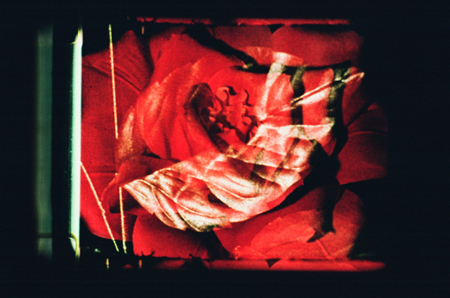Thursday, November 3, 6:00 pm | Archival print!
Introduced by film historian Bruce Jenkins and followed by audience Q&A with Jenkins and avant-garde film scholar P. Adams Sitney (who will join us via Skype).

- Image from ENIAIOS II (Gregory Markopoulos, 1949-1991). Courtesy the Temenos Archive and the Austrian Film Museum, Vienna.
Remembered as the “supreme erotic poet” of the American avant-garde, Gregory Markopoulos spent decades creating his monumental film Eniaios, an eighty-hour composition of twenty-two cycles. Eniaios (meaning “unity” or “uniqueness”) was originally conceived for screening at Temenos, Markopolous’s open-air theater in the hills overlooking Lyssaraia, Greece. Silent yet sensuous, the film journeys through a host of imagery, including pulses of white light, passages of black, fragments of earlier works, and images of sacred places. Markopoulos died before Eniaios could be printed and his partner, filmmaker Robert Beavers, has spent the last two decades restoring the work. Only six of the twenty-two film orders have been printed thus far. Tonight’s screening of Eniaios II — the second cycle in the piece and an epic film in its own right — affords a rare opportunity to view Markopoulos’s magnum opus in the making. Gregory Markopoulos, 1949-1991, Greece/USA, 16mm, 125 min plus discussion.
Eniaios VI – VIII will premiere June 29 – July 1, 2012 at the Temenos in Lyssarea (Arcadia) Greece. For more info, visit: www.the-temenos.org.
GREGORY MARKOPOULOS (1928-1992) was born in Toledo, Ohio to Greek immigrant parents. He attended Film School at USC in the 1940s and became a key figure in the New American Cinema movement with others like Jonas Mekas, Shirley Clarke, and Stan Brakhage. A critic and teacher, Markopoulos founded the filmmaking program at the School of the Art Institute of Chicago in 1965. He and his partner Robert Beavers emigrated to Europe in 1967 after which he removed all of his films from circulation, refused interviews, and insisted that a chapter about him be deleted from the second edition of Visionary Film, P. Adams Sitney’s seminal study of American avant-garde cinema. In the later part of his life, he focused almost entirely on the production of Eniaios.